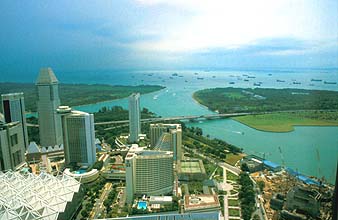Today, Singapore is cited as a perfect example of a wellplanned and sustainable city. This 697 sqkm citystate has emerged as a beautiful city primarily because of its approach to urban development.
Planning is key
Singapore owes its transformation from a colonial town to a high-tech city to visionary Lee Kuan Yew who is credited with not just with building the region's finest infrastructure of roads, airport, port and communication networks, but also upgrading its economy. During the 1960s, Singapore not only faced a severe housing shortage but it also suffered from inadequate infrastructure and high rate of unemployment.
Over the next 30 years, its leaders were committed to beautifying the city and improving its economy. New towns emerged, land was set aside for industries and a good transportation network and infrastructure came up. Planning was, in fact, the key to its transformation.
Planning with a long-term perspective, integrated planning , and planning for implementation are the three principles on which Singapore's development has and is taking place. A long-term perspective for a period of 40-50 years was adopted and a strategic land use and transportation plan called the Concept Plan, which is reviewed every 10 years, was devised.
An integrated approach means all land use demands and requirements are accounted for like transport and utility, commercial and residential spaces etc. Since many agencies, both government and private, are involved, an inter-agency committee coordinates between them. Lastly, it is ensured that plans charted out are implemented successfully with public-private partnership playing a key role.
Link
Planning is key
Singapore owes its transformation from a colonial town to a high-tech city to visionary Lee Kuan Yew who is credited with not just with building the region's finest infrastructure of roads, airport, port and communication networks, but also upgrading its economy. During the 1960s, Singapore not only faced a severe housing shortage but it also suffered from inadequate infrastructure and high rate of unemployment.
Over the next 30 years, its leaders were committed to beautifying the city and improving its economy. New towns emerged, land was set aside for industries and a good transportation network and infrastructure came up. Planning was, in fact, the key to its transformation.
Planning with a long-term perspective, integrated planning , and planning for implementation are the three principles on which Singapore's development has and is taking place. A long-term perspective for a period of 40-50 years was adopted and a strategic land use and transportation plan called the Concept Plan, which is reviewed every 10 years, was devised.
An integrated approach means all land use demands and requirements are accounted for like transport and utility, commercial and residential spaces etc. Since many agencies, both government and private, are involved, an inter-agency committee coordinates between them. Lastly, it is ensured that plans charted out are implemented successfully with public-private partnership playing a key role.
Link





Enviar um comentário 0 comentários: